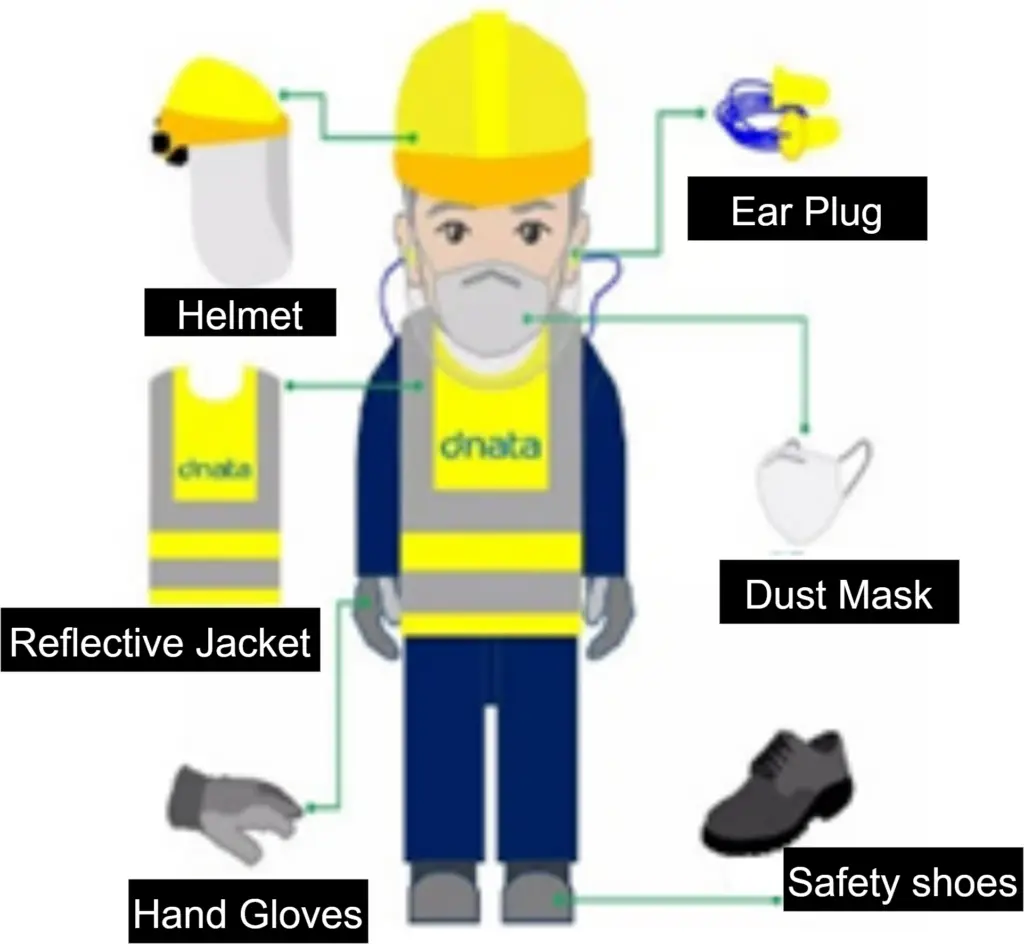What is PPE?
Before we know what PPE is, let us know about the hazards first. A hazard can be a source or a situation that can cause injury or ill health to humans. In any industry, different hazards are present depending upon the manufacturing process of that industry.
The safety of the employees is of utmost importance to the employer, and continuous efforts are made for well being of employees in hazardous industrial environments. To reduce the person’s exposure to hazards few standard types of equipment are provided to employees as a control measure when administrative and hazard elimination methods are not feasible, that is known as PPE. PPE reduces the risk of exposure to hazard to an acceptable level.
Types of Personal Protective Equipment(PPE)
PPE is generally of two kinds.
- Mandatory PPE
- Job Specific PPE
1. Mandatory Personal Protective Equipment(PPE)
1a. Helmet
A safety helmet or Hard hat is a PPE for head protection against falling object or fall of persons from a height.

It is made of High-density polyethylene (HDPE), Polycarbonate, and polyamide. safety helmets are excellent impact resistance and high toughness. Safety helmets are provided with a chin strap that secures the head and helmet and it prevents rolling off.
1b. Shoes
Safety shoes are protective footwear that protects feet and toes. They are provided with a toe Cap that has a minimum compressive strength of 15 KN.

Safety shoes must have an impact resistance of 200 Joules. Safety shoes shall be resistant to oil, acid, and electric current. Shoes must be lightweight, slip and abrasion resistant.
1c. Reflector Jacket
It is a safety clothing that allows the wearer to be seen and to alert all that a person is present in a low visibility situation.

They are generally bright in color with reflective tapes stitched on them.
1d. Dust Mask
It protects the wearer against harmful microorganisms, droplets, and inhalation of dust in the air and protects the lungs.

It is made up of polypropylene either spun bond or melt blown.
1e. Safety Goggles
It shields the eyes against dust, a splash of harmful liquid, and fumes. It covers the eyes, eye sockets, and facial area around the eyes.

They are generally made of polycarbonate and are 3 mm thick. It must be scratch resistant.
2. Job-specific Personal Protective Equipment(PPE)
2a. PPE for welding activities
High temperatures (3000 degrees), metal spattering, and hazardous gases are various hazards associated with welding work that can cause burns and respiratory troubles.

Only authorized persons must perform welding work wearing standard welding PPEs such as welding caps, dust masks, safety glasses, welding helmets, welding gloves, leather aprons, leather boots, and spats.
2b. PPE for grinding & cutting activities
High noise, shattering of grinding discs, flying metal particles high-speed sharp wheels, are common hazards during grinding and cutting work. Operators may easily sustain cuts, abrasions, burns, and eye injury while such activity.

Hand gloves Ear plugs, dust masks, face shields, and safety goggles are important PPEs for such work.
2c. PPE for Noise Prone Area
70 Decibels(dB) is considered normal for human ears anything above it is noise pollution.

In industry machinery, high-level noise can affect the person working nearby. Ear plugs & ear muffs can be used as protective equipment in such areas to reduce noise levels.
2d. PPE for High-temperature Zone
Fire suit is the protective equipment for persons working in high-temperature areas. The suits are designed according to various temperature applications.

Generally, three types of fire suits are available to approach fire- suits (93 degrees), proximity fire suits (260 degrees), and entry suits (1100 degrees).
2e. PPE for Hazardous chemical Area
Suits used as protective equipment for chemical protection are known as hazmat suits, these suits protect against toxic chemicals, biological agents, and radioactive material.

It is used by firefighters, medical crew, paramedics, researchers, and persons dealing with toxic spills. These suits are generally gaseous tight.
2f. PPE for Electrical work
Burns, shock, and electrocutions are hazards associated while working on any electrical system. Voltage-graded rubber hand gloves, arc protection suits, rescue hooks, earth discharge rods, rubber insulated mats & coatings, and Dielectric shoes are protective equipment(PPE )used for electrical work.

Rubber hand gloves shall be periodically inspected for any damage and shall be discarded after the expiry date is over.